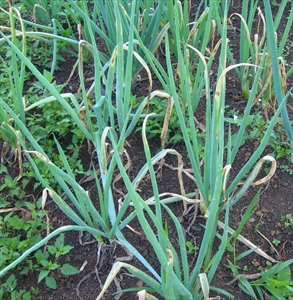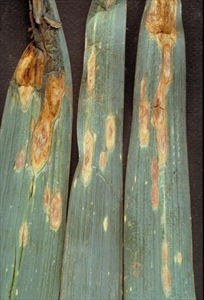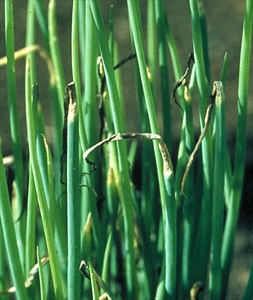Onion purple blotch
Pacific Pests, Pathogens, Weeds & Pesticides - Online edition
Pacific Pests, Pathogens, Weeds & Pesticides
Onion purple blotch (151)
Alternaria porri
Asia, Africa, North, South and Central America, the Caribbean, Europe, Oceania. It is recorded from Australia, Fiji, French Polynesia, New Caledonia, New Zealand, Palau, Papua New Guinea, Samoa, and Vunuatu.
Onion, and also shallot, garlic and leek.
Spots on the leaves are at first small with white centres, but expand rapidly into oval, brown to purple blotches, several centimetres long (Photos 1-4). Light and dark rings appear on the blotches. If the blotches grow around the leaves, or merge, the parts above the blotch wilt, collapse and die (Photo 1). The leaf tips are commonly infected (Photo 5). The bulbs can also be infected at harvest; infection is usually at the neck where a watery yellow to red rot develops.
The disease is favoured by high humidity, and can also occur as a secondary infection on plants damaged by other pests, e.g., onion thrips.
The fungus survives on crop debris on or in the soil for at least a year. Spores of the fungus are produced in the brown to purple blotches (Photo 2) and are spread by wind, rain splash and, possibly, by insects. Heavy dews or rains favour the disease, as the leaves need to stay wet for 8 hours for the spores to infect. Older leaves are more susceptible, especially those damaged by the onion thrips. Spread on seed has been reported, but is probably rare.
A 'blotch' is a word that describes a large irregular mark; in this case the blotch occurs on the leaves. Onion blotch is a common disease, especially in hot humid countries. It is said to be the most common disease of onion in Samoa. It occurs throughout the year, but damage is greater during the drier season when heavy dews occur. Losses are more than 40% in Samoa, and are reported to be higher in other countries. In parts of the Philippines, the area planted to the red onion variety was reduced to half that usually planted in 2016 because of the disease. Losses may continue to develop post-harvest.
Look for the characteristics large brown to purple blotches. Look for tips of leaves that blacken and hang down, wither and die.
CULTURAL CONTROL
Cultural control is particularly important in the management of this disease:
Before planting:
- Certified seed: Ensure that the seed is disease-free by using that which is commercially packaged.
- Inspect nursery plants: Check plants in the nursery and remove any seedlings that show leaf spots before transfer to the field.
During growth:
- Watering: Use a drip irrigation system rather than overhead irrigation to avoid long periods of leaf wetness, which assists infection by spores.
- Nutrition: In Samoa, applications of manure to improve the vigour of the plants is said to reduce disease severity.
- Harvest: Harvest when plants are mature, and preferably during dry weather. Cure bulbs before storage
After harvest:
- Hygiene: Remove plant debris after harvest or incorporate it into the soil so that it decomposes quickly. Remove any "volunteer" onions that develop.
- Crop rotation: Do not plant crops of onion one after another without a break; leaves a gap of at least 3 years between consecutive crops.
RESISTANT VARIETIES
Resistance has been reported in onion and also in garlic.
CHEMICAL CONTROL
If chemical control is necessary, use:
- Protectant products: copper (e.g., cuprous oxide), mancozeb, chlorothalonil. Of the three, mancozeb and chlorothalonil are commonly used in countries experiencing outbreaks of purple blotch.
- Systemic products: triazole fungicides.
____________________
When using a pesticide, always wear protective clothing and follow the instructions on the product label, such as dosage, timing of application, and pre-harvest interval. Recommendations will vary with the crop and system of cultivation. Expert advice on the most appropriate pesticide to use should always be sought from local agricultural authorities.
AUTHOR Grahame Jackson
Information (and Photo 3) from Gerlach WWP (1988) Plant diseases of Western Samoa. Samoan German Crop Protection Project, Deutsche Gesellschaft für Technische Zusammenarbeit (GTZ) Gmbh, Germany; and Diseases of vegetable crops in Australia (2010). Editors, Denis Persley, et al. CSIRO Publishing; and from Madeiras A (undated) Alliums, purple blotch. The Center for Agriculture, Food and the Environment. University of Massachusetts Amherst. (https://ag.umass.edu/vegetable/fact-sheets/alliums-purple-blotch). Photo 2 Howard F. Schwartz, Colorado State University, Bugwood.org. Photos 3&5 Kohler F, et al. (1997) Diseases of cultivated crops in Pacific Island countries. South Pacific Commission. Pirie Printers Pty Limited, Canberra, Australia. Photo 4 Howard F. Schwartz, Colorado State University, Bugwood.org.
Produced with support from the Australian Centre for International Agricultural Research under project PC/2010/090: Strengthening integrated crop management research in the Pacific Islands in support of sustainable intensification of high-value crop production, implemented by the University of Queensland and the Secretariat of the Pacific Community.








